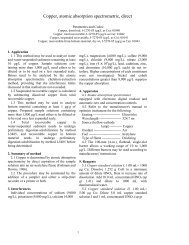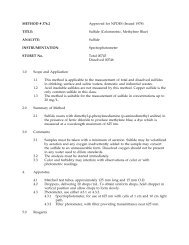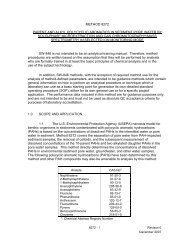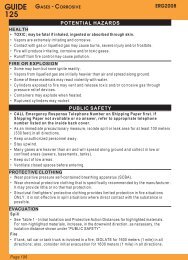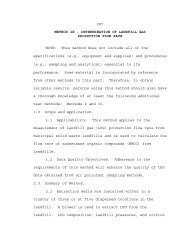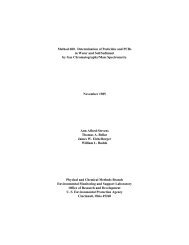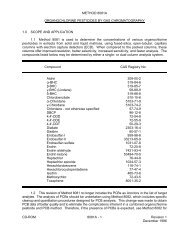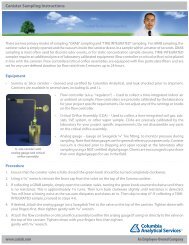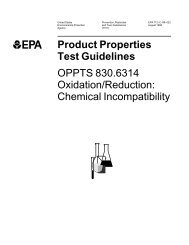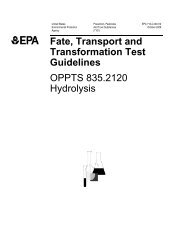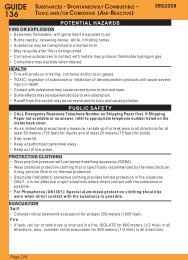EPA Method 317 - Columbia Analytical Services
EPA Method 317 - Columbia Analytical Services
EPA Method 317 - Columbia Analytical Services
- No tags were found...
Create successful ePaper yourself
Turn your PDF publications into a flip-book with our unique Google optimized e-Paper software.
option.14.2 Quantity of the chemicals purchased should be based on expected usage during itsshelf-life and disposal cost of unused material. Actual reagent preparation volumesshould reflect anticipated usage and reagent stability.14.3 For information about pollution prevention that may be applicable to laboratories andresearch institutions, consult "Less is Better: Laboratory Chemical Management forWaste Reduction," available from the American Chemical Society's Department ofGovernment Regulations and Science Policy, 1155 16th Street N.W., Washington D.C.20036, (202) 872-4477.15. WASTE MANAGEMENT15.1 The Environmental Protection Agency requires that laboratory waste managementpractices be conducted consistent with all applicable rules and regulations. Excessreagents, samples and method process wastes should be characterized and disposed ofin an acceptable manner. The Agency urges laboratories to protect the air, water, andland by minimizing and controlling all releases from hoods and bench operations,complying with the letter and spirit of any waste discharge permit and regulations, andby complying with all solid and hazardous waste regulations, particularly the hazardouswaste identification rules and land disposal restrictions. For further information onwaste management consult the "Waste Management Manual for Laboratory Personnel,"available from the American Chemical Society at the address listed in Section 14.3.16. REFERENCES1. U.S. <strong>EPA</strong> <strong>Method</strong> 300.1. <strong>EPA</strong> Document number: <strong>EPA</strong>/600/R-98/118. NTIS numberPB98-169196 INZ.2. Wagner, H.P., Pepich, B.V., Hautman, D.P. and Munch, D.J. “Analysis of 500 ng/L Levelsof Bromate in Drinking Water by Direct Injection and Suppressed Ion ChromatographyCoupled with a Single, Pneumatically Delivered Postcolumn Reagent.” JournalChromatography A, 850 (1999), 119-129.3. Wagner, H.P., Alig, A.E., Pepich, B.V., Frebis, C.P., Hautman, D.P. and Munch, D.J. “AStudy of Ion Chromatographic <strong>Method</strong>s for Trace Level Bromate Analysis in DrinkingWater Comparing the Selective Anion Concentration (SAC) <strong>Method</strong>, U.S. <strong>EPA</strong> 300.1 and aPostcolumn Reagent Procedure.” AWWA WQTC Proceedings, 4D-1, San Diego, CA,(November 1998).4. Wagner, H.P., Pepich, B.V., Hautman, D.P. and Munch, D.J. “Performance Evaluation of a<strong>Method</strong> for the Determination of Bromate in Drinking Water by Ion Chromatography (<strong>EPA</strong><strong>317</strong>.0 - 32



